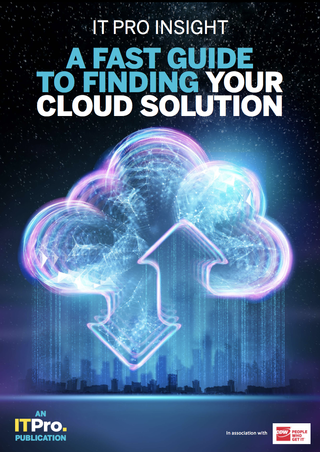
It's safe to say that the cloud is one of the most important innovations in modern IT, with a huge number of businesses moving to take advantage of benefits such as flexibility, cost savings and ease of deployment. Fittingly enough, however, the cloud' is a broad and somewhat woolly term that encompasses myriad technologies, all of which serve slightly different purposes.
For organisations looking at cloud adoption, it's important to know exactly what cloud' means to you. Migrating to the cloud without a firm understanding of your objectives can lead to over-investment in services which may not be necessary for achieving them which can, in turn, result in the costly repatriation of workloads later down the line.
When is a cloud not a cloud?
First things first – when most people talk about the cloud, they're generally talking about the three major public cloud platforms Amazon Web Services, Google Cloud Platform and Microsoft Azure. These specialise in platform as a service (PaaS), serverless functions, containerisation orchestration and infrastructure as a service (IaaS) offerings, and are most commonly used for building and running modern applications and providing simplified abstractions for complex services such as machine learning, business analytics and AI. They essentially allow companies to command instances of a virtual data centre, where the company is responsible for building and maintaining the software elements, and the cloud provider takes care of the physical hardware they run on, or even further up the stack, the cloud vendor is also responsible for the operating system where abstraction through serverless functions or containerisation takes place.
This is incredibly useful for any company that wants to adopt a new consumption-based compute economy and develop software (whether for internal or external use), but that's not all they do. Public cloud platforms can also be used to host instances of business apps such as CRM systems, websites, app servers and databases. These platforms are incredibly versatile, but they generally require a relatively high level of configuration and management, with a complex set of skills needed to do anything at scale and to remain security conscious.
"It's not as easy as many cloud vendors make it out to be. If you go to any cloud vendor's website, they tell you that you can be consuming their cloud services immediately, just with a credit card," says Lee Wynne, CDW's Public Cloud Architecture Practice Lead, "and you can for some services such as basic cloud storage or static website hosting; you just put your credit card details in and away you go, but if you're a big organisation and you're security conscious, then there's quite a lot of design work required just around the account and billing structure before you get anywhere near the platform infrastructure.
"For example, you've got to think about how to reduce the blast radius of a compromised account, using the principle of least privilege', isolating costs on a per-subscription basis, creating an emergency account, centralised logging and restrict human access to it the list goes on.
"And then on top of that, you then get into questions like what regions and availability zones are you going to use, what's going to have access to the internet, what isn't, subnet isolation and range, when to use a transit VPC (AWS) or VNet (Azure), perimeter and platform security and whether machine learning will play a part, as well as which workloads are modern enough to be HA by default. All those types of things require a methodical approach and you'll soon find out that the learning curve needed to just host a file service or static website just sloped skywards, and so did the level of accountability."
File-sharing platforms, on the other hand, are much more user-friendly. These services typified by the likes of Box, Dropbox and Google Drive used to be known as cloud storage' services, but their growing feature-set has rendered that definition somewhat unhelpful. Although they still act as a cloud-based central repository for business files and folders, most providers now offer features beyond basic storage, typically geared towards enabling greater efficiency and collaboration within the business.

A fast guide to finding your cloud solution
One size doesn't fit all in the cloud, so how do you find the best option for your business?
Common features of file-sharing platforms include the ability to leave comments on files, integrations with other SaaS tools (which we'll talk more about later) and thorough version histories and audit logs, as well as in-depth permission settings to ensure that no-one has access to anything they shouldn't. File-sharing is an essential tool for any organisation; not only does it help protect files from accidental loss in the event of a hardware failure, it also allows staff to access them from any location or device, improving mobility and enabling flexible or remote working.
It's important to note that while file-sharing services can be used to back up documents and provide similar functionality to that of a backup service, the two are not interchangeable. Unlike storage platforms, backup providers focus on keeping a complete archive of all of your data, rather than just files and documents. This includes things like databases, server configurations and emails, to ensure that if anything disastrous (such as a ransomware infection or a flood) happens to your IT systems, you can quickly and easily restore them to their state before the incident.
There are many different backup options available depending on your needs; some specialise in server or VM-level backups, some focus on endpoint devices and others cover the full range of tasks. Dedicated backup services tend to concentrate on what's known in the industry as cold storage' meaning data that isn't intended to be accessed on a regular basis. For this reason, many use snapshots to restore affected systems to a specific point in time. Backup platforms are an excellent disaster recovery tool to ensure you can get operational again as quickly as possible should the worst happen, but they're also helpful for meeting regulatory and compliance requirements.
Collaboration station
Gone are the days when businesses were forced to rely on lengthy email chains to share knowledge and files with each other. Now, cloud-based collaboration platforms and communication services help employees to stay in touch. Instant messaging apps are among the most popular examples of this, with Slack and Microsoft Teams being leaders in the field. Combining the functionalities of a message board, a chat app and a digital workspace, collaboration apps support direct messages, private group chats, public channels and company-wide forums, allowing communication across many levels.
These services often include telephony tools like basic audio and video calling, but they also integrate directly with popular third-party conferencing tools like Zoom and BlueJeans for those that need more features. File-sharing, communication and collaboration tools are also frequently cross-compatible, allowing employees to, for example, share relevant files without leaving a video call.
Outside of the tools and services highlighted above, there are various types of standalone SaaS software to suit businesses specific needs; virtually every breed of business application has a cloud-based equivalent, whether it's a CRM system, accounting package or database management tool. Organisations can cherry-pick which applications they need to build their ideal software stack, and many feature cross-compatibilities and integrations with other services to enable different workflows.
Some cloud services will suit every business. There are few organisations, for example, that wouldn't benefit from the increased mobility and flexibility offered by a good file-sharing service. However, the combination of different cloud services is where businesses can unlock real value. We've already covered the way file-sharing, collaboration and unified comms services can work well together, a particularly effective mix for creative-driven businesses like marketing or design firms, but there are configurations to suit every organisation.

A fast guide to finding your cloud solution
One size doesn't fit all in the cloud, so how do you find the best option for your business?
Any company that has a substantial software development practice, for example, would be well-served by adopting a cloud platform such as Microsoft Azure and combining it with comprehensive VM backup and code-sharing tools allowing them to develop and deploy applications rapidly and at scale without the risk of sudden loss of work.
Finding the right blend of cloud services, as well as the best way to combine them for maximum efficiency and cost savings can be a real challenge for organisations looking to start exploring the world of cloud.
By partnering with CDW, businesses can get a helping hand with this complex and often daunting process, giving them access to a trusted advisor with the expertise to accelerate their journey to of a well thought out billing and account structure, global platform design and strong baseline security principles with built in cost management in preparation for the inevitability of cloud consumption.
Get in touch with a CDW Account Director and ask for details on CloudCare® JumpStart or CloudPlan. Visit uk.cdw.com
Get the ITPro. daily newsletter
Receive our latest news, industry updates, featured resources and more. Sign up today to receive our FREE report on AI cyber crime & security - newly updated for 2024.
ITPro is a global business technology website providing the latest news, analysis, and business insight for IT decision-makers. Whether it's cyber security, cloud computing, IT infrastructure, or business strategy, we aim to equip leaders with the data they need to make informed IT investments.
For regular updates delivered to your inbox and social feeds, be sure to sign up to our daily newsletter and follow on us LinkedIn and Twitter.





